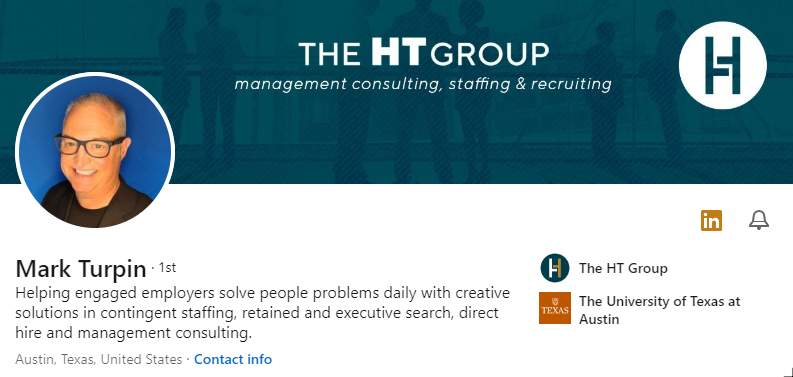Recruiters use LinkedIn every day to find candidates. And, if they connect with you elsewhere first, they’ll use LinkedIn to learn more about you.
Therefore, how you use LinkedIn as a job seeker matters, from what you post in your profile to how you interact. To that end, we asked The HT Group Technical Recruiter Celeste Mortensen to give job seekers her top tips based on how recruiters use LinkedIn.
First, it’s OK to be skeptical. Many job seekers have become leery of job searching on LinkedIn because of the sheer number of bots and scammers posing as legitimate recruiters, which is understandable. But that doesn’t mean LinkedIn isn’t filled with reputable recruiters eager to find you. When a recruiter reaches out with a job opportunity, do a little digging on that recruiter to, at the very least, verify that they’re a real person. Follow these additional tips as well. And never, ever pay upfront for a job or recruiter.
Don’t use automated responses. A canned response to a job shared on LinkedIn, like “I would like to learn more about this opportunity,” will surely be ignored. Recruiters can also fall prey to bots and scammers when they use LinkedIn, so they’ll avoid interactions that don’t seem genuine. “What would you like to learn? What interests you about the role? What questions can I answer? It’s important to give me anything that confirms you read the message and not just the subject line,” Mortensen says, adding that it’s a double whammy when a candidate doesn’t respond to questions the recruiter fires back, like “When are you available to chat?”
Match your resume to your LinkedIn (to your real life, please). “I see a lot of ‘Start date – Present,’ but then, when I get the resume, it turns out the candidate hasn’t worked since 2022,” Mortensen explains. “What’s worse is when neither the resume nor the LinkedIn profile shows the correct dates. It’s fine if someone hasn’t worked in a while, but it’s better to disclose that upfront. Don’t wait for the recruiter or employer to dig into your history or try to get references only to find that you left the company eight months ago.”
Don’t over-list your technical skills. “You don’t need to list the technical skills you’re not using, not interested in using, or only studied for two days in college. While it may seem beneficial to come up in as many searches as possible, it can devalue your true top skills and make it unclear on what type of job it is you’re actually qualified for or interested in doing,” Mortensen advises, adding the example of a Cyber Security Analyst who wants to work in Cyber Security. “They don’t C++ or Waterfall at the top of their profile.”
Be discoverable. When recruiters use LinkedIn, they often run targeted searches to find candidates who best fit their needs. To show up in the right searches, keep your location current and consider using the “open to work” function, either publicly or just for recruiters to see (more tips about that here). “This is particularly helpful for filling contract or short-term positions. It’s unlikely I’ll try to pull someone out of what looks like an eight-year tenure for a job that lasts six months. That’s another good reason to include the end date if you’re not currently working. Maybe you had a long tenure and just got laid off, but without that information, I am more likely to interact with the candidate who appears interested in new opportunities,” Mortensen admits.
Use the space below your name (the “Headline” section) to highlight your value. This one comes from The HT Group Founder and CEO Mark Turpin, who admits that seeing that spot underutilized is a bit of a pet peeve. “Just putting your job title there is a wasted opportunity,” he says. “Use that space to sell yourself because you know that 100% of the people interviewing you will be pulling up your LinkedIn profile before they make a decision.” See more tips here, and take a look at Mark’s own headline for inspiration:

Don’t burn bridges. Lastly, says Mortensen, it’s a good idea to respond to recruiters who use LinkedIn to find you, even if the opportunity isn’t quite right. “I always appreciate a quick note, even if the candidate isn’t interested. ‘Thanks for reaching out, but it’s not a match; I’m only looking for remote work; or I’m not looking at this time’ goes a long way,” she adds. It can keep you in the recruiter’s pipeline and give them a better idea of the type of job you’re seeking.
Searching for the right job can be one of the hardest things you’ll ever do. Use LinkedIn to make it easier and do much of the legwork for you. The better you are at setting yourself up for success, the more likely you’ll be found by great recruiters.




